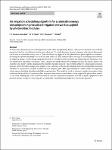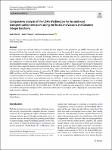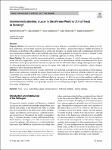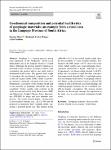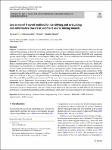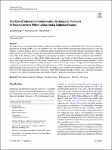Search
Author
- Osman, Ahmed I. (5)
- Chen, Zhonghao (2)
- Ricohermoso III, Emmanuel (2)
- Wang, Yongbin (2)
- next >
Subject
- LCA (6)
- ICP-MS (3)
- Artificial intelligence (2)
- CDW (2)
- next >
Date issued
Has File(s)
- true (220)
Search Results
The quality of life in rural housing settlements is at the heart of territorial cohesion concerns across Europe and the United Nations’ sustainable development goals. However, the gap between urban and rural developments remains substantial, stressing the need to adopt integrated approaches for rural territories. These approaches should include heritage preservation strategies as a priority. Vernacular constructions integrate rural built heritage and comprise a sustainable response of communities in territories, stressing the pertinence of its rehabilitation. The aim of this paper is to raise awareness of this issue through a scoping review since it lacks general frameworks that may contribute towards perceiving rural territories and their constructions as catalysts of territorial c... |
To meet water demands, pressurised irrigation networks often need pumping devices, whose power demand varies with the pump head, the flow rate delivered and the pump efficiency. To satisfy the energy demand of pumps, solar photovoltaic panels can be used as a renewable energy source. Since the electricity supply of a solar photovoltaics plant depends on irradiance, the energy that powers the pump varies with the time of the day. This study presents a strategy for scheduling water delivery by irrigation pumps, synchronising energy production in solar photovoltaic modules and minimising the installation size. An optimisation algorithm is proposed, which changes the energy required by pumping devices and adjusts them to the available solar energy supply, minimising the number of panels... |
The concept of the study resulted from numerous concerns around bisphenol A (BPA) and bisphenol S (BPS) in aquatic environments. In this study, river water and sediment microcosms highly polluted with bisphenols and bioaugmented with two BPs-removing bacterial strains were constructed. The study aimed to determine the rate of high-concentrated BPA and BPS (BPs) removal from river water and sediment microniches, and the effect of water bioaugmentation with bacterial consortium on the removal rates of these pollutants. Moreover, the impact of introduced strains and exposure to BPs on the structural and functional composition of the autochthonous bacterial communities was elucidated. Our findings indicate that the removal activity of autochthonous bacteria was sufficient for effectivel... |
Chengdu-Chongqing economic circle (hereinafter referred to as “Chengyu Region”) is a key construction region of China's major development strategy. The development of regional tourism plays an important role in the optimization of regional economy and industrial structure. In this paper, ArcGIS 10.5 was used as the main analysis tool to analyze the temporal and spatial distribution of A-level tourist attractions in Chengyu Region, and makes factor analysis and interactive analysis on the factors affecting the distribution of tourist attractions by geographic detector model. The results show that: 1. The distribution of tourism attractions in Chengyu Region is mainly concentrated type, and the distribution of the natural landscape, cultural landscape, rural pastoral and modern entert... |
Countries’ sectors are currently under great scrutiny for their response to the greenhouse gas (GHG) emission profile and the general effect of the sectoral activities on the environment. As in the agenda of all sectors, environmental concerns and investigations are of high importance in shipping and maritime transport. Amidst the rising forms of globalization, the need for sustainable transportation is constantly increasing. However, the machines that are the cornerstone of transportation largely depend on fossil fuels, thus resulting in environmental degradation. Notably, environmental-related degradation has continued to account for global warming, climate change, and ocean acidification. Shipping is considered the most environmentally friendly mode of transportation in terms of ... |
Finding out how to scale innovations successfully is high on the agendas of researchers, practitioners and policy makers involved in agricultural development. New approaches and methodologies seek to better address related complexities, but none of them include a systematic perspective on the role of capacity in (partnerships for) scaling innovations. We posit that this has left an important topic insufficiently addressed in relation to partnerships for scaling innovations. The need to address this gap became apparent in the context of the CGIAR Roots, Tubers, and Bananas (RTB) Scaling Fund initiative. |
Gremmeniella abietina is a destructive forest pathogen responsible for Scleroderris canker, shoot dieback, defoliation, and tree death in forests and tree nurseries. This review is aimed at providing a complete description of the fungus, its distribution, the conditions for its spread, and the impact of climate change and at summarising the relevant forest management methods. Due to the worldwide importance of the pathogen, a retrospective review is required to summarise the lessons learned in relation to the disease, considering application to future outbreaks. |
Geophagy is a common practice among rural population of the Fetakgomo Tubatse Local Municipality area in the Limpopo Province of South Africa. Although, the practice might be beneficial to the health of the consumers, its negative effects could overshadow the positive effects and might lead to detrimental health issues. The present work sought to investigate the geochemical composition as well as pH and organic matter (OM) content of geophagic materials commonly consumed in the study area. Furthermore, assessment of the potential health risk of the materials on geophagic individuals was also considered. Twelve samples were collected in the study area and analysed by X-ray Fluorescence (XRF) and Inductively Coupled Plasma—Mass Spectrometry (ICP-MS) for major and trace elements compos... |
Accelerated soil erosion poses a global hazard to soil health. Understanding soil and sediment behaviour through sediment fingerprinting enables the monitoring and identification of areas with high sediment delivery. Land-use specific sediment source apportionment is increasingly determined using the Bayesian mixing model MixSIAR with compound-specific stable isotopes (CSSI). Here, we investigate CSSIs of fatty acid (FA) tracer selection with a novel method to identify and investigate the effect of non-informative tracers on model performance. |
The major sources of macronutrients (nitrate, ammonium, phosphate, and silicic acid) in Jakolof Bay, Alaska are submarine groundwater discharge (SGD), rivers, and offshore water. We estimated SGD using natural geochemical tracers (radon and radium), a salt mass balance, and a two-component salinity mixing equation based on the change in groundwater salinity on falling lower low tide. Previous studies have hypothesized that the major macronutrient input into Jakolof Bay is offshore water. This study challenges that assumption by determining the relative contribution of macronutrients from SGD relative to offshore water and rivers. |


